| |||||||
| Search Forums |
| Advanced Search |
| Go to Page... |
 |
| Search this Thread |  112,083 views |
| | #121 | |
| BHPian Join Date: Jul 2019 Location: Nagercoil TN74
Posts: 126
Thanked: 441 Times
| Re: Tata Nexon: Global NCAPís first 5-Star Indian car Quote:
| |
| |  ()
Thanks ()
Thanks
|
| |
| | #122 | |
| BHPian Join Date: Nov 2020 Location: Mohali
Posts: 216
Thanked: 771 Times
| Re: Tata Nexon: Global NCAPís first 5-Star Indian car Wakey wakey, it's time to revive a dead thread! Fortunately for me, it hasn't been locked— yet. I doubt if anyone will ever read this, but for what it's worth, I'll pen down some new findings of mine— well, technically not mine; it would be disingenuous to take all credit and present them as something I thought of on my own. I'll credit the inspiration for the highly speculative post that is about to follow. It will involve a lot of tomfoolery and mental gymnastics, so if anyone is reading this and still wishes to continue on this futile endeavour, here is your viewer discretion is advised warning. And no, you won't get these precious minutes of your life you just spent reading this back. First of all, I would like to thank the source of my inspiration and essentially the very core of my speculation.  Some background: I have been frequenting GNCAP's YouTube channel ever since Autocar's rumour suggesting that the Kiger is in for a test at GNCAP. I was casually strolling through some videos on their channel, checking out the description for additional information/comments about those crashes until this comment right here, with the black profile picture piqued my interest. If you don't know Hindi, the commenter points out that the code assigned to the 4-star Nexon test vehicle exactly matches the one used by the 5-star Nexon test vehicle. He questions why the same video has been used for the 5-star Nexon, as he is confused (probably) about the legitimacy of these tests. As I set out to investigate the claim made by the commenter, I found the following: 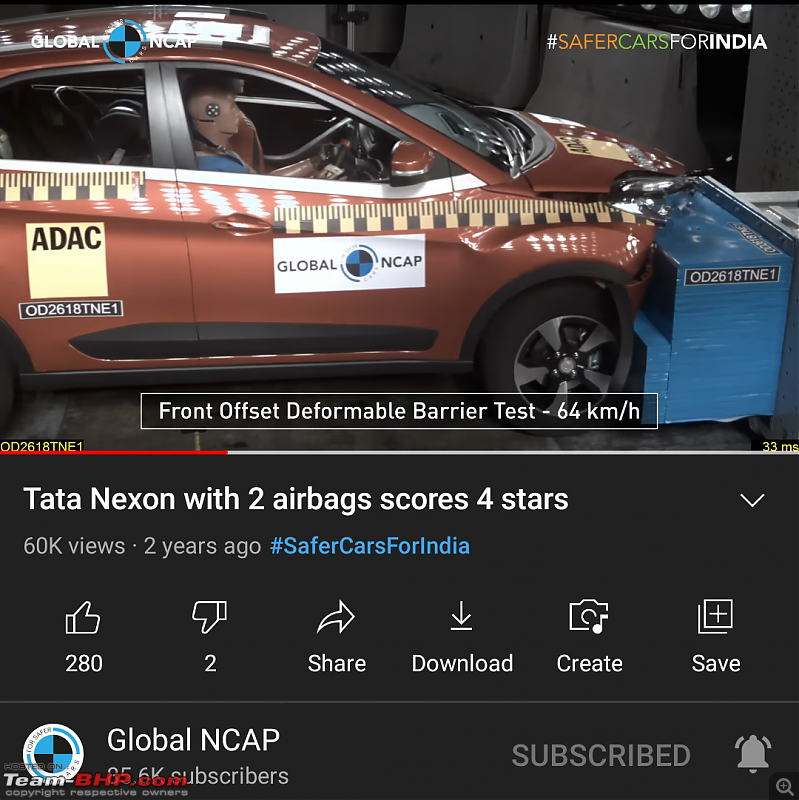 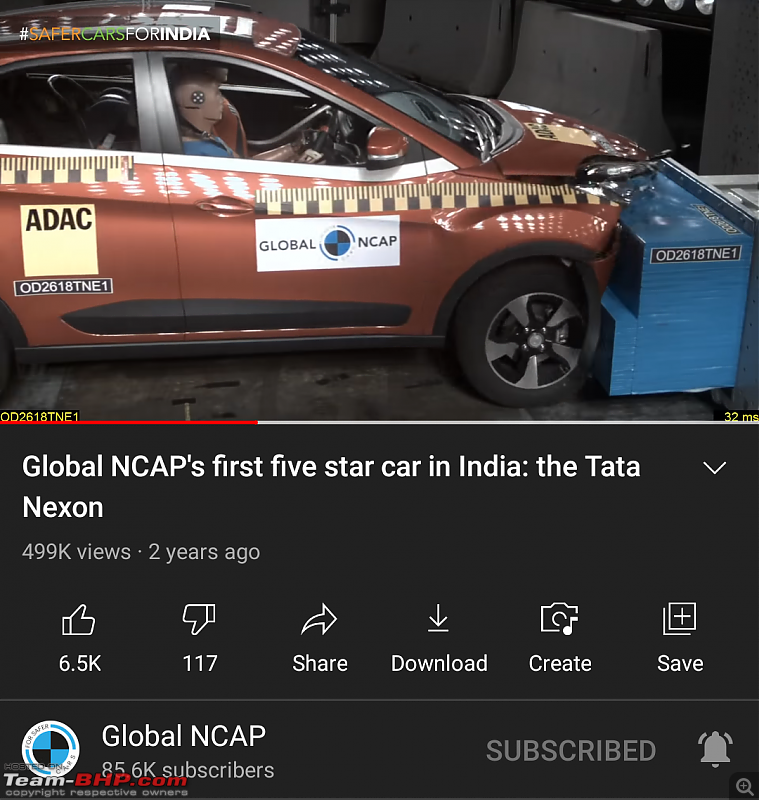 What's the difference, you ask? Well, one is titled Nexon scores 4 stars while the other is titled India's first 5 star car. Further, if you look at the codes on the rear door of both the Nexons, it reads: OD2618TNE1 Q: What's the big deal then? It's just some technical mumbo jumbo they might be using for Nexons in particular, right? A: Well, here's the technical mumbo jumbo on the side impact test: 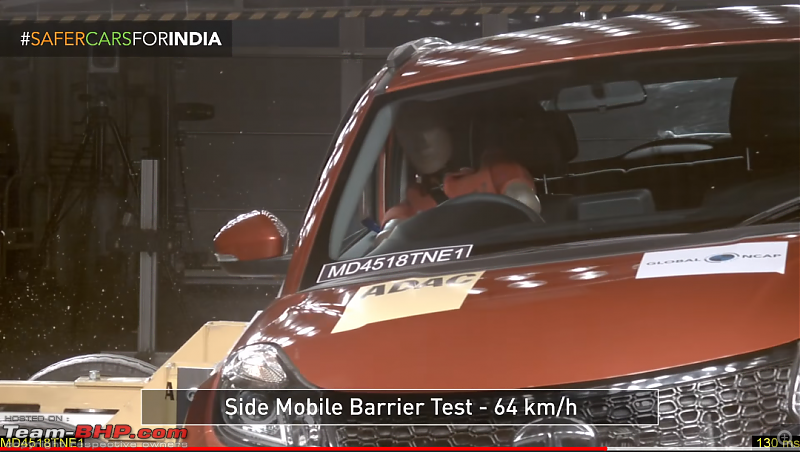 It reads: MD4518TNE1 Q: What is this mumbo jumbo? A: I haven't fully deciphered what each and every letter and number means, but lets look at a few more of these codes from another car. 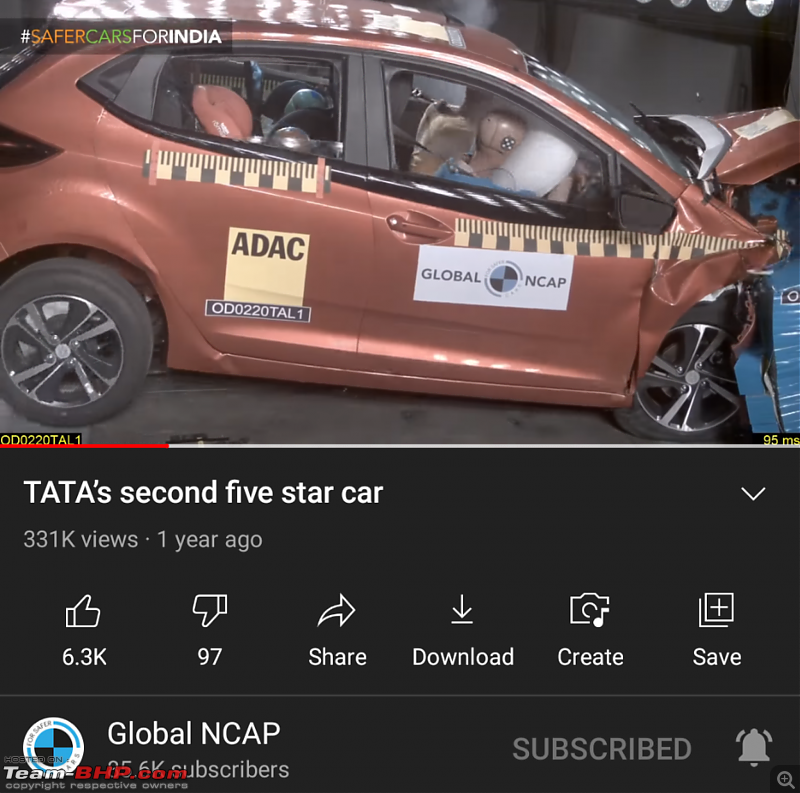 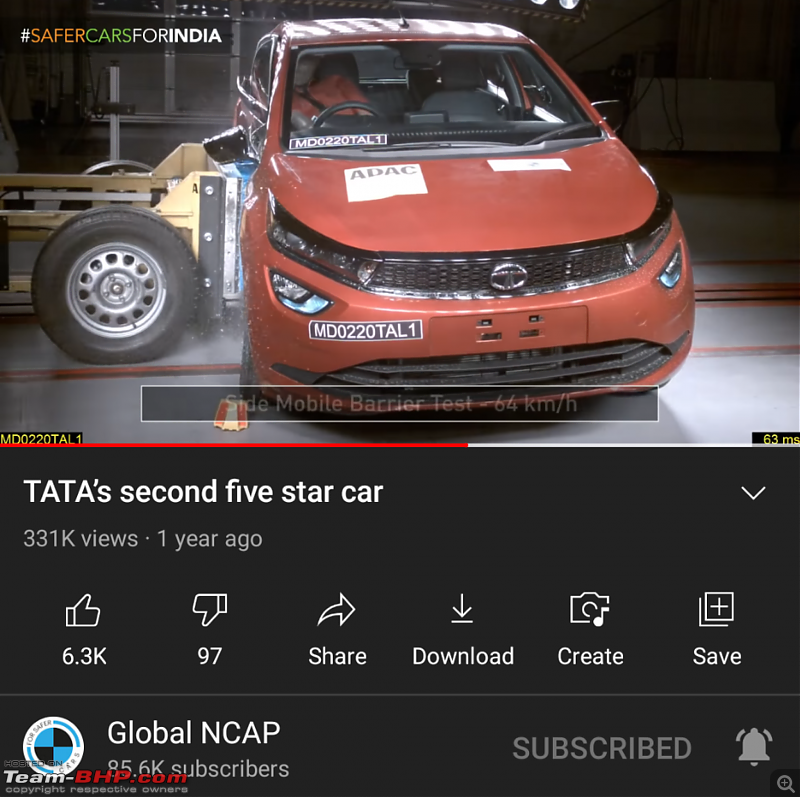 For the offset test, the Altroz reads: OD0220TAL1 For the side impact test, the Altroz reads: MD0220TAL1 We see some similarities and some differences. What I have worked out after looking at half a dozen other tested cars and thinking (to myself) for about half an hour or so, is as follows: 1. OD stand for Offset Deformable, while MD stands for Mobile Deformable. 2. The first letter T in TAL stands for the car manufacturer, in this case Tata. The succeeding AL represents the initials of the car— ALtroz. Similarly for Nexon, TNE means Tata NExon. 3. The 18 in Nexon's OD2618TNE1 and MD4518TNE1 stands for the year in which the car was tested, i.e. 2018. Similarly for Altroz, the 20 in OD0220TAL1 and MD0220TAL1 represents the year 2020. 4. Now this is the part where I'm not really sure about my speculation. I think that the 26 in OD2618TNE1 stands for the 26th week of the year 2018, whereas the 45 in MD4518TNE1 stands for the 45th week of 2018, meaning that the Nexon for ODB test was in the lab by the 26th week of 2018, whereas the Nexon for the MDB test arrived in the lab only by the 45th week of 2018. It doesn't make sense for Tata to have sent their 5-star Nexon with the updated chassis the same week they sent the Nexon which eventually got a 4-star, because the result of the 4-star Nexon was published much later (about a month at least). This speculation is solidified by looking at the codes on the Altroz— 02 in OD0220TAL1 and MD0220TAL1 stands for the 2nd week of 2020, according to me. So, both the ODB and MDB vehicles for Altroz arrived in the 2nd week of 2020, unlike Nexon. The reason I'm kind of unsure about this week theory part is because LATIN NCAP and EURO NCAP's publishing guidelines are something like this: Quote:
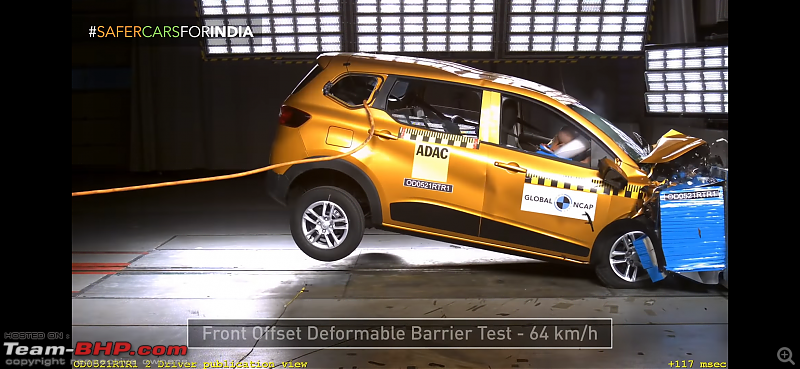 OD0521RTR1 means that the car has been in the lab since 5th week of 2021, i.e. somewhere around the beginning of February this year, while the results were published on 1 Jun, almost 4 months later. To give GNCAP the benefit of the doubt, and assuming my speculation is correct, these are unprecedented times and EURO NCAP has written that this is what they generally follow, not something absolute. 5. I do not know what the digit at the end stands for. It is generally a 1, but in case of XUV 300, it was OD0320MXU1 for ODB test and MD0320MXU2 for MDB test. 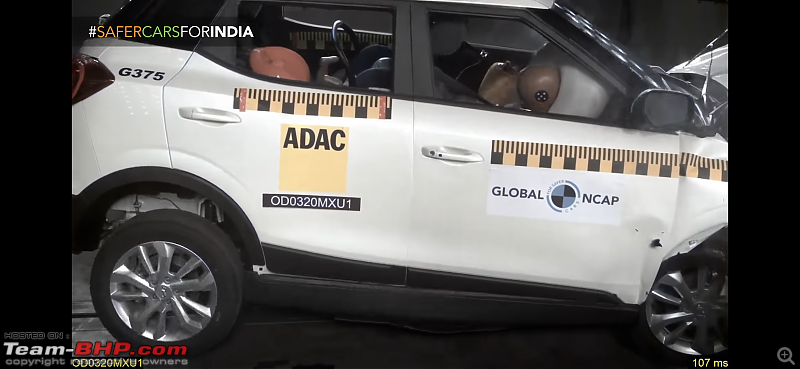 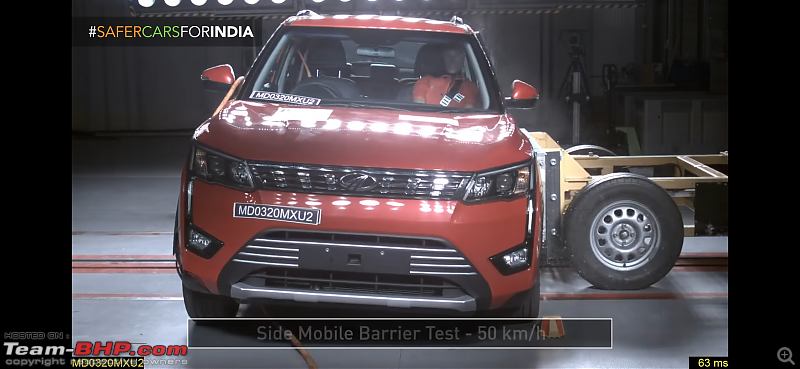 Compare this to the Altroz where it was 1 at the end for both the tests and I'm not able to reasonably conclude anything about the last digit. So where does this all lead me to? Am I suggesting that GNCAP tests are rigged? No. The point here is that many of us believed that Tata sent a new Nexon with some improvements in its chassis even for the ODB test to get a 5-star rating, which may not necessarily be the case in the wake of these findings. The improved protection to the upper leg / thigh region definitely supported that assumption. What I think would have happened, is that, instead of sending a new vehicle for ODB test, Tata showed GNCAP their own in-house crash data (since they have their own crash testing facility) after they made changes to the chassis. GNCAP would have verified the documents demonstrating the changes to the chassis and checked whether Tata's in-house crash data correlates to the documents submitted by them. After they were satisfied with their investigation, they would have accepted Tata's crash test data and given the Nexon a five star rating, after it passed the side impact test and scored a perfect 1 point in SBR. If anyone manages to read this confused rambling, do let me know what you think of this speculation.  Last edited by Aditya : 22nd October 2021 at 19:04. Reason: As requested | |
| |  (71)
Thanks (71)
Thanks
|
| The following 71 BHPians Thank rpm for this useful post: | abhi9044, AdityaDeane, amit_purohit20, anandhsub, anshuman1117, arjab, Arnav Vaghela, audioholic, Avikbrio, Bibendum90949, blackstallion76, BoneCollector, brownkaiser, carthick1000, CEF_Beasts, chinmaypillay, dailydriver, dhruvwali, digitalnirvana, dsr001, fiat_tarun, giri1.8, Goku_YNWA, govigov, GTO, Harjot37, hdman, headbanger, HMV, HSR21, igemini, irajput, jothishX, Latheesh, Mu009, museycal, N33raj, naadopaasaka, Nexusios1521, Nitish B Shetty, ph03n!x, quantobigboot, Raghuwire, ram87pune, Rambo-RS, ramnaresh_2000, Researcher, Rigid Rotor, ron178, rrsteer, saikishor, sainyamk95, Shrayus_shirali, Shreyans_Jain, Shreyas, Siva Prakash, Sowgandh.Bellam, spd_tkt, srikanthmadhava, SuhairZain, Swaraj65, swiftnfurious, Tgo, The_Outsider!, Turbokick, VTec_KickedInYo, Xaos636, YD14, yesyeswe, ynike99, ysjoy |
| | #123 | |
| BHPian Join Date: Jun 2020 Location: IN
Posts: 86
Thanked: 172 Times
| Re: Tata Nexon: Global NCAPís first 5-Star Indian car Quote:
 Last edited by Nexusios1521 : 28th June 2021 at 19:12. | |
| |  (13)
Thanks (13)
Thanks
|
| The following 13 BHPians Thank Nexusios1521 for this useful post: | irajput, Latheesh, Rambo-RS, Researcher, Rigid Rotor, rpm, Shrayus_shirali, slango97, SuhairZain, swiftnfurious, TorqueIndia, VTec_KickedInYo, YD14 |
| | #124 | ||
| BANNED Join Date: Sep 2020 Location: Back to India
Posts: 141
Thanked: 740 Times
| Re: Tata Nexon: Global NCAPís first 5-Star Indian car Quote:
Quote:
Actually there was quite a discussion over this feature deletion back in the day. People were upset about about the feature deletion, and that it was a security hazard (as someone might just open the door, grab your laptop on the rear seat, and run away while you are stuck in traffic) etc. Something similar happened with the Thar recently. The Thar front-facing was tested, and got 4 stars. But GNACP said we will let you advertise this as a 4-star car, only if you discontinue the side facing variant (which doesn't even have rear seat-belts). And Mahindra did as asked, and discontinued the Thar AX, making the AX side-facing seat variant rarer than a unicorn. PS: I really dislike Tata Motors, and everything that they do, so, if anything I can be accused of having an anti-Tata bias, instead of in favour of them, but lets not go down the lane of conspiracy theories, especially not on this forum. Last edited by vb-saan : 29th June 2021 at 05:20. Reason: Typos | ||
| |  (8)
Thanks (8)
Thanks
|
| The following 8 BHPians Thank S15 for this useful post: | InControl, Latheesh, Raghuwire, Rigid Rotor, rpm, Seenz, SuhairZain, swiftnfurious |
| | #125 | ||
| BHPian Join Date: Nov 2020 Location: Mohali
Posts: 216
Thanked: 771 Times
| Re: Tata Nexon: Global NCAPís first 5-Star Indian car Quote:
1. The car must score minimum 14.00/16 points in the offset deformable barrier test itself. Do note that this score only includes the ODB test, not the SBR. The 1 point allotted to SBR is a separate requirement independent of the ODB score. 2. The car must score a perfect 1 point for SBR. 3. The car must pass ECE95 side impact test. 4. The car must have 4 channel ABS. Let's have a look at the crash result pdf of both, the 4-star Nexon and the 5-star Nexon. 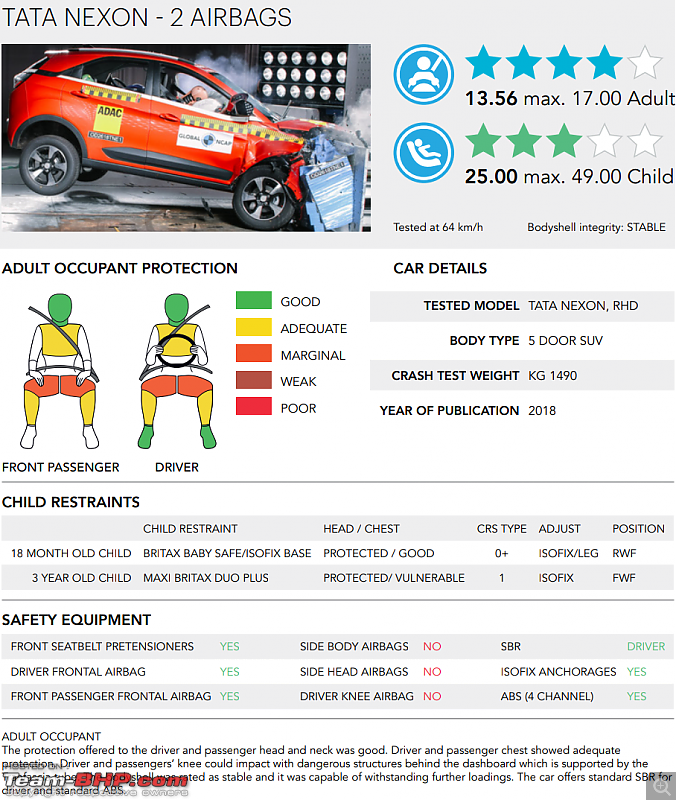 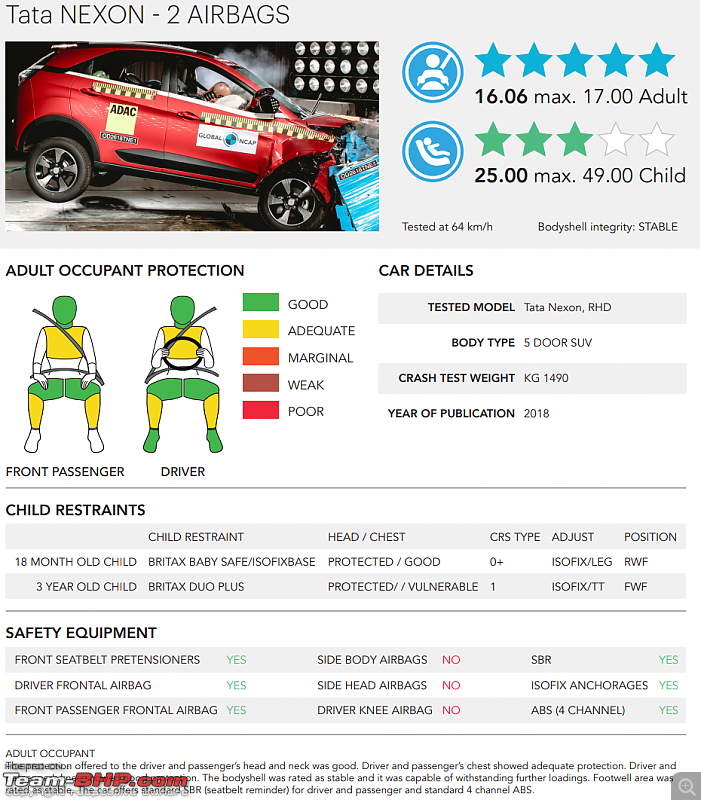 As you will observe, the 4-star Nexon managed a 4-star rating with a score of 13.56. It had 4-channel ABS, so the 4th requirement had already been fulfilled. While SBR was present, the pdf clearly mentions SBR for only the driver, meaning, it scored only 0.5 points in SBR. The scoring criteria for SBR is as follows: Quote:
Since this Nexon didn't score 14/16 in ODB itself, it wasn't eligible for further evaluation for a 5-star rating, meaning that any number of side tests and safety features would not have made any difference to its rating, unless they made changes which could affect the ODB score and catapult it beyond the 14 point threshold. This is also evident in the crash result pdf, as we see the upper leg / thigh protection increase from marginal (orange) to good (green), giving it the needed push to be eligible for further testing in the form of side impact test. Once it passed that, it just needed passenger side SBR to cement its 5-star rating, because all other features were already present in the 4-star Nexon except the ODB score and passenger SBR. Just as a fun exercise, let us consider your scenario where additional safety features would have made a difference. The only difference in safety features between the 4-star Nexon and the 5-star Nexon which represents such a possibility is the SBR. You'll see in the pdf that 4-star Nexon only had driver side SBR, while 5-star Nexon had both, driver and passenger SBR. If, for example, they just made changes to SBR and applied for a 5-star rating / retest with the unaltered 4-star Nexon, the following would happen: 1. Passenger side SBR would grant the 4-star Nexon an additional 0.5 points, taking its total score to 14.06/17. 2. It would still get a 4-star rating because its ODB score would still be 13.06. So, for a 5-star rating, the minimum overall score needed by a car is 14 points ODB + 1 point SBR = 15.00/17 points. | ||
| |  (25)
Thanks (25)
Thanks
|
| The following 25 BHPians Thank rpm for this useful post: | AdityaDeane, AntPaul, Bibendum90949, blackstallion76, CEF_Beasts, fiat_tarun, Harjot37, InControl, Mu009, museycal, Nitish B Shetty, ph03n!x, ram87pune, Researcher, Rigid Rotor, ron178, sainyamk95, Sayan, Seenz, SuhairZain, swiftnfurious, Tgo, Tucker48, Vasanth, ysjoy |
| | #126 | |||
| Senior - BHPian Join Date: Nov 2019 Location: India
Posts: 1,539
Thanked: 8,008 Times
| Re: Tata Nexon: Global NCAPís first 5-Star Indian car Quote:
Regarding your speculation about the score, your observations seem sound. A minimum of 14 points in the ODB test + 1 point for SBR (thus a total of at least 15 out of 17 including the full SBR point) + UN95 side impact pass + 4-channel ABS are required for the 5th star. Since the Nexon scored 13.56 in the first test and probably already scored half a point for driver SBR - I don't see any comments about it not meeting requirements - (meaning the ODB test score is probably 13.06), it scored 4 stars. Now, the UN95 side impact and 4-channel ABS contribute nothing to the overall score, they're merely 5-star requirements. So, how did the score jump from 14.06 to 16.06? Well, here lies your answer. The ODB test score did increase despite a second test not being conducted by Global NCAP. Observe the comments and the colour-coded dummies in both reports and you'll see that the ratings for all driver and passenger knees increased from orange to green. This is because the one-point variable contact modifier for each leg was removed by Global NCAP, presumably following a sled test conducted by Tata. (since knee modifiers are not a structural issue, they may be assessed without a destructive test. Quoting the Global NCAP Adult Occupant Protocol, Section 3.2.1.3: Knee, Femur and Pelvis Quote:
Quote:
Just for example (I'm picking the best 4-star car I can find here), the Honda Amaze (or at least the South African one) scores a rather impressive 14.08/17 including half a point for driver SBR, which means that the ODB score is 13.58. Now I can't say for sure that Honda would qualify for removal of the knee modifiers, but in a hypothetical situation where these modifiers could be removed, the ODB test score would stand at 15.58, then if Honda added passenger SBR, the total score out of 17 would stand at 16.58 leaving the Amaze a UN95 side impact test away from being a 5-star car. Effectively, removing even one modifier could let Honda pass the 14/16 ODB threshold. However this is just a huge assumption and I request readers not to assume anything from what I've said in this paragraph. Unless tested again all current 4-star cars including but not limited to the South African Honda Amaze are still 4-star cars, it's merely an example. (The Amaze and many other four star cars lack ESC and side airbags anyway, which will not help when Global NCAP updates its assessment protocol next year). EDIT: I think the reason the 5-star rating applies only to later VINs is because of the addition of standard passenger SBR. If you regularly buckle up and own a 4-star Nexon, I think it's pretty safe to assume you're driving a 5-star car (technically, no, since all said and done it does not have the passenger SBR) since obviously, no structural changes were actually made. Global NCAP uses modifiers to indicate that the possibility of damage/injury could be worsened at higher speeds, higher loading or less overlap. It does not actually mean that there was high injury during the test, just that there is a risk of further injury. In the same way an unstable bodyshell modifier does not mean the structure collapsed during the test, a knee modifier does not mean the knees were badly injured during the test. Global NCAP simply observed dangerous structures behind the dashboard that could contact the knees, but Tata proved that they would not be so. Tata would have not sponsored the side impact test the first time anyway due to the ODB score not being met. To sum up, First test: 15.06-2.00=13.06 ODB, 0.50 driver SBR, 4 channel ABS, no side impact Second test: 15.06 ODB, 1.00 SBR, 4 channel ABS, side impact conducted because 14/16 ODB score was passed It would be very interesting indeed to know where it was learnt that structural changes were made. It could be wrong on Tata's part to make a statement like this if they did, assuming what I've mentioned above about the knee modifier removal holds true. Last edited by ron178 : 28th June 2021 at 22:32. Reason: Mentioned in post | |||
| |  (23)
Thanks (23)
Thanks
|
| The following 23 BHPians Thank ron178 for this useful post: | AdityaDeane, anandhsub, AntPaul, blackstallion76, CEF_Beasts, fiat_tarun, giri1.8, InControl, Latheesh, Mu009, museycal, Nexusios1521, ph03n!x, Rambo-RS, Researcher, Rigid Rotor, rpm, Seenz, sierrabravo98, SuhairZain, swiftnfurious, Tgo, ysjoy |
| | #127 | |
| BHPian Join Date: Nov 2020 Location: Mohali
Posts: 216
Thanked: 771 Times
| Re: Tata Nexon: Global NCAPís first 5-Star Indian car Quote:
This explanation puts an end to my speculation. It perfectly aligns with your explanation, while also bringing clarity that chassis/structural changes were probably not required to achieve a 5-star rating. I was merely able to figure out the fact that ODB test was not conducted thanks to someone else's YouTube comment and whatever little I was able to decipher from the code on the vehicle, but your explanation perfectly explains why the ODB test wasn't reconducted. I had suspected Tata providing in house data to get the rating, but I wasn't sure of the nature of it. Your post very clearly delineates the provision of a sled test for removing knee modifiers. With that, I'm now reasonably sure that no structural changes were probably made. Your extra insight about the African Amaze was the icing on the cake. I would like to thank you again for this beautifully written post. Thank you. PS: @Nexusios1521, the post above, by BHPian ron178 is a far better answer to your query. Please ignore my earlier post. EDIT: I think that this is not something that Tata had claimed. It was more of a popular assumption back then because of the increase in score from 13.56 to 16.06, just like many of us had wrongly assumed that Tata sent a new vehicle for ODB test to get a 5-star rating. BHPian Vid6639 had also likely accepted the general notion about chassis/structural changes that was prevalent back then. I think he would be overjoyed to learn about these new findings. Last edited by rpm : 28th June 2021 at 23:23. | |
| |  (7)
Thanks (7)
Thanks
|
| The following 7 BHPians Thank rpm for this useful post: | Bibendum90949, Mu009, ph03n!x, ram87pune, Researcher, Rigid Rotor, ron178 |
| | #128 | |
| Senior - BHPian | Re: Tata Nexon: Global NCAPís first 5-Star Indian car Quote:
Weíll leave that problem to be solved by NCAPs themselves until we find out what the last digit means. Could it be a designation for base-mid-top variant? | |
| |  (5)
Thanks (5)
Thanks
|
| The following 5 BHPians Thank Tgo for this useful post: | AdityaDeane, InControl, Researcher, Rigid Rotor, rpm |
| | #129 | |
| BHPian Join Date: Nov 2020 Location: Mohali
Posts: 216
Thanked: 771 Times
| Re: Tata Nexon: Global NCAPís first 5-Star Indian car Quote:
 As of now, the last number is as mysterious to me as it is to you. The number 2 at the end is especially a very rare occurrence, even for cars that undergo both the ODB and MDB test. I guess it now becomes the collective responsibility of the forum to find out what this mystery number means.  I would agree with you that it is probably something related to the variants of the car. This is what I had in mind when writing my original post too, but without reasonable enough evidence to back me up, I left it out, because I wouldn't be able to reasonably explain which variants were signified by those numbers. The base-mid-top variant theory could work, except I have never seen the number 3 or 0 at the end. Then again, I have also not seen every single crash test video out there. It would for sure be very interesting to see what code GNCAP uses for XUV 700. Guess that gives the two of us one more thing to look forward to other than the crash rating. Last edited by rpm : 28th June 2021 at 23:54. | |
| |  (3)
Thanks (3)
Thanks
|
| The following 3 BHPians Thank rpm for this useful post: | Latheesh, Mu009, ph03n!x |
| | #130 | |||||
| Senior - BHPian Join Date: Nov 2019 Location: India
Posts: 1,539
Thanked: 8,008 Times
| Re: Tata Nexon: Global NCAPís first 5-Star Indian car Quote:
Quote:
Quote:
Quote:
The Hyundai i10, Volkswagen Polo and Maruti Alto without airbags both had two tests each performed on them - the UN R94 56 km/h test (whose footage was not revealed to the public except for the Nano) and the NCAP 64km/h test. If you observe the Tata Nano's thumbnail on the Global NCAP website, the UN R94 test has the number one (since it was the first test conducted) and all other cars (for which only NCAP 64 km/h results were displayed) have the number 2. However, mysteriously, the Nano's NCAP test has the suffix 1 too. Similarly, the Renault Kwid's third structural iteration had two tests conducted on it (one without an airbag and one with) - one is labelled as 1 and the other as 2. However this does not hold true for the Honda Mobilio, Tata Zest or Volkswagen Polo with airbags. Anyway, I don't think it's worth discussing in depth. Quote:
Mods, sorry for going off-topic, I was trying to answer a question. Last edited by ron178 : 29th June 2021 at 00:42. | |||||
| |  (6)
Thanks (6)
Thanks
|
| The following 6 BHPians Thank ron178 for this useful post: | AZT, Latheesh, Mu009, museycal, Rigid Rotor, rpm |
| | #131 | |||
| BHPian Join Date: Nov 2020 Location: Mohali
Posts: 216
Thanked: 771 Times
| Re: Tata Nexon: Global NCAPís first 5-Star Indian car Quote:
The second person he asks, however, could be interpreted to be talking about Tata's vision of conforming to crash norms in general. He seems to be talking about achieving crash norm compliance while the Nexon was still in the pre-production phase where they were trying to meet the weight, timeline and budget targets while developing a safe vehicle. The reason for this assumption is that the host says the following at 5:40ó it was positive to see that these changes were brought into production well before any test was even carried out. Now this could either be the 2nd test or the 1st test, or both. If there were indeed some structural changes for the 2nd test, maybe they would be to incorporate side impact compliance? I so wish BHPian ram87pune could throw some light on this if his insider sources have any information regarding the same. Quote:
So, as it turns out, the suffix 2 is indeed used when a second test is conducted on the same iteration of the car, but only if it arrived at the lab the same week as the first one! Example: Kwid 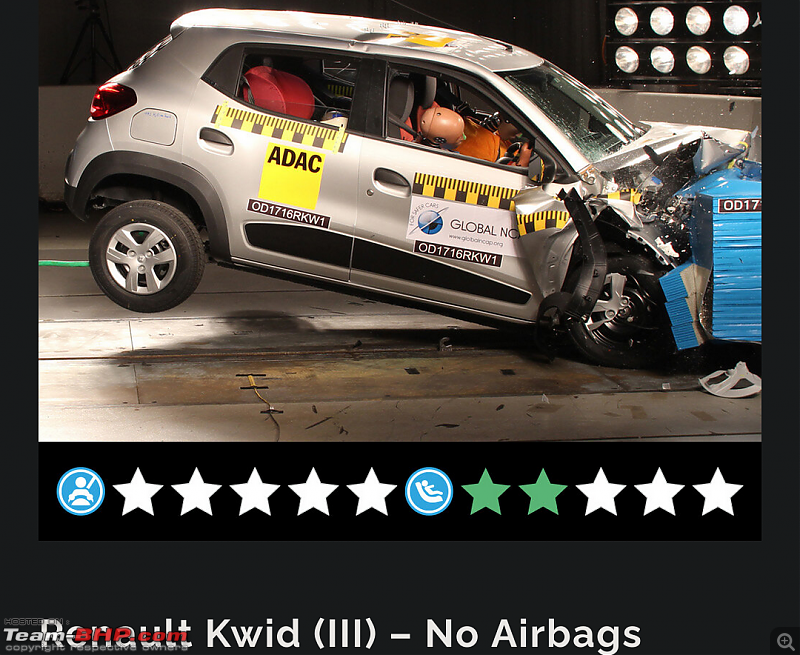  But the Altroz isn't too happy to see my lackluster makeshift theory and stages a coup d'etat. 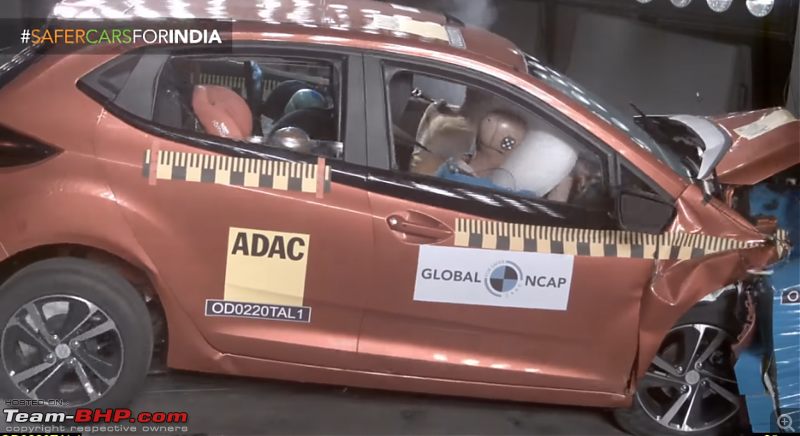 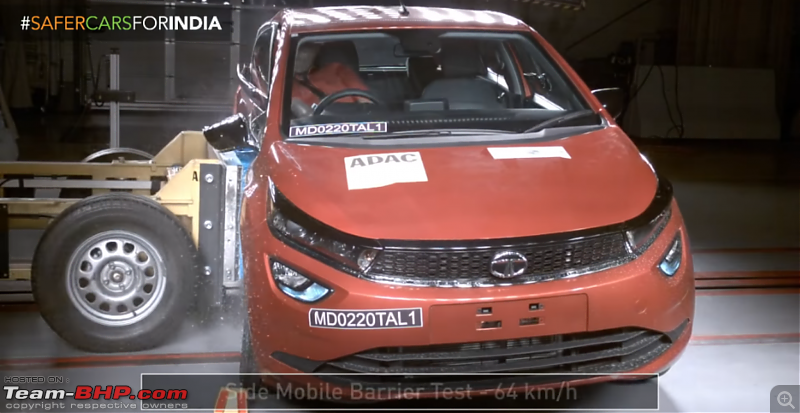 Does the Altroz succeed? Almost. Except. It doesn't. The mStallion is here to stall its plans, just like it stalled Altroz's plan of claiming the number 1 spot at GNCAP as the safest car in India. 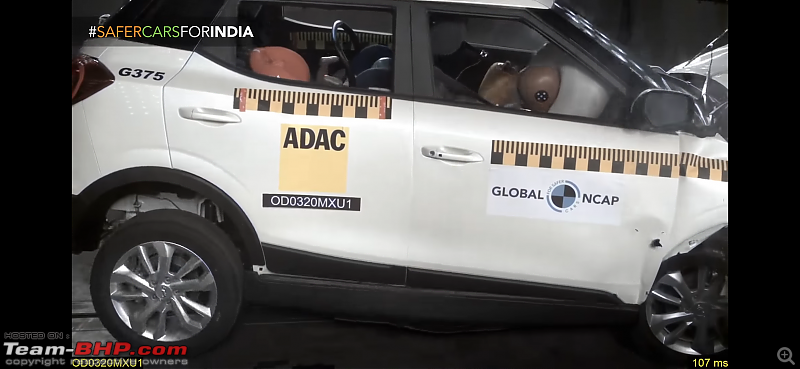 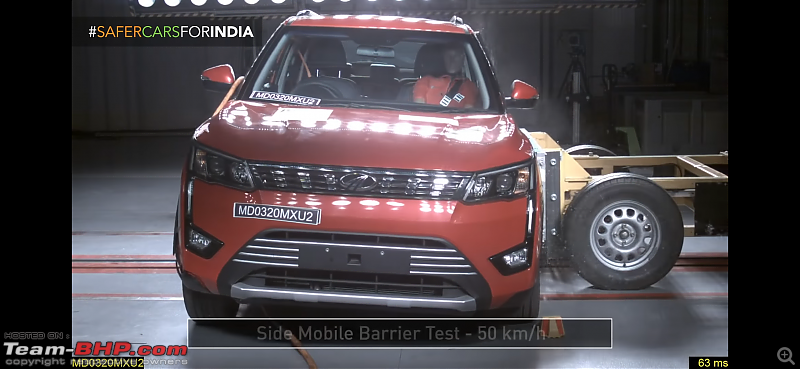  So, ladies and gentlemen, I present to you, an even more makeshift version of my makeshift theory. It readsó The suffix 2 represents the 2nd car of the same iteration/make, on which another test is to be conducted, provided that the 2nd car not only arrives at the lab the same week as the first car, but also has a different color than the 1st car. Quote:
Also, I wasn't really expecting anyone to read my confused rambling on what was essentially a dead thread, but not only did a lot of people read it, I even got a reply which has my original post outclassed and outmatched in every aspect. Kudos to you and your automotive knowledge in the field of crash tests, Sir.  | |||
| |  (10)
Thanks (10)
Thanks
|
| The following 10 BHPians Thank rpm for this useful post: | CEF_Beasts, InControl, Mu009, ph03n!x, Researcher, Rigid Rotor, ron178, sainyamk95, swiftnfurious, Tgo |
| |
| | #132 | ||||
| Senior - BHPian Join Date: Nov 2019 Location: India
Posts: 1,539
Thanked: 8,008 Times
| Re: Tata Nexon: Global NCAPís first 5-Star Indian car Quote:
Quote:
Quote:
Quote:
So long, and we'll discuss the number when the next tests come out. Fingers crossed for another 5-star car  . . | ||||
| |  (3)
Thanks (3)
Thanks
|
| The following 3 BHPians Thank ron178 for this useful post: | ph03n!x, Rigid Rotor, rpm |
| | #133 | |
| BHPian Join Date: Nov 2020 Location: Mohali
Posts: 216
Thanked: 771 Times
| Re: Tata Nexon: Global NCAPís first 5-Star Indian car
While casually going through the pictures I had uploaded, I just noticed that side impact test for XUV 300 is shown to be done at 50 km/h, while the Nexon and Altroz have been subjected to 64 km/h. Is the speed for the MDB described under UN 95 test flexible? I have seen Euro NCAP tests varying between 50 and 60 km/h too, but then, how is the speed for the MDB decided? Any thoughts? Also, you missed this question from my earlier post.  Quote:
| |
| |  (1)
Thanks (1)
Thanks
|
| The following BHPian Thanks rpm for this useful post: | ron178 |
| | #134 | ||||||
| Senior - BHPian Join Date: Nov 2019 Location: India
Posts: 1,539
Thanked: 8,008 Times
|
I believe someone had mentioned this, either in the YouTube comment section or on this forum. However, in retrospect, I'm not too sure about my statement about the Seltos, though it holds true for the Nios because of the black window frames (the Era gets body-coloured frames) and the touchscreen infotainment system in the interior shots in the video. Some of the manufacturer-sponsored tests (The Tatas and the Mahindras) clearly have higher variants as evidenced by the presence of alloy wheels. Even the Nexon tested wasn't the base model (I believe the base trim of the Nexon doesn't get black window frames - I remember seeing one in the neighbourhood) Quote:
The UN95 side impact protocol is available for public viewing here. You'll find what I mentioned in point 3 of Annex 4 of Page 22. For reference, here is the section of the UNECE '95 side impact protocol regarding test speed. Hence there is a very, very remote possibility of the side impact test having been conducted at 64km/h though it's highly unlikely. Quote:
Quote:
Quote:
Quote: Quote: Last edited by vb-saan : 30th June 2021 at 09:15. Reason: Back-to-back posts merged. Thank you! | ||||||
| |  (6)
Thanks (6)
Thanks
|
| The following 6 BHPians Thank ron178 for this useful post: | avinash_clt, Bibendum90949, JithinR, Rigid Rotor, rpm, swiftnfurious |
| | #135 | ||||
| BHPian Join Date: Nov 2020 Location: Mohali
Posts: 216
Thanked: 771 Times
| Re: Tata Nexon: Global NCAPís first 5-Star Indian car Quote:
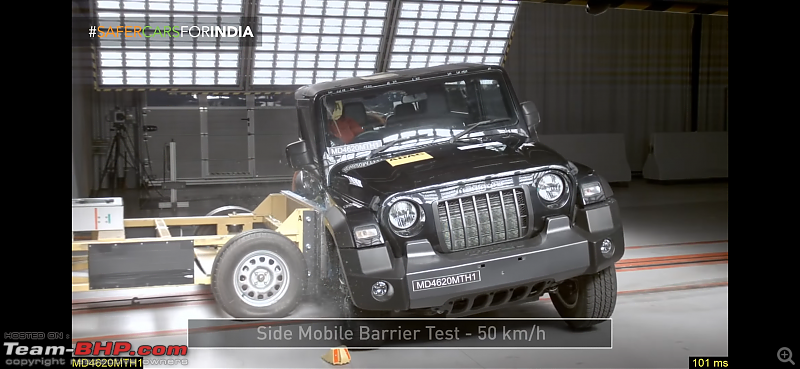 Here, we see the driver side being struck, just like the Nexon and Altroz, yet the speed is 50 Km/h. Quote:
Quote:
Quote:
My best guess about the 'why' would be Mahindra itself. They were likely pushing for the safest in India crown, and might have gone a little overboard to get any and everything tested. This is evident in their proactive approach of getting ESC tested on both, the Thar and XUV 300. They even sponsored two new XUVs for the safer choice award, so that pedestrian protection and ESC could be tested. 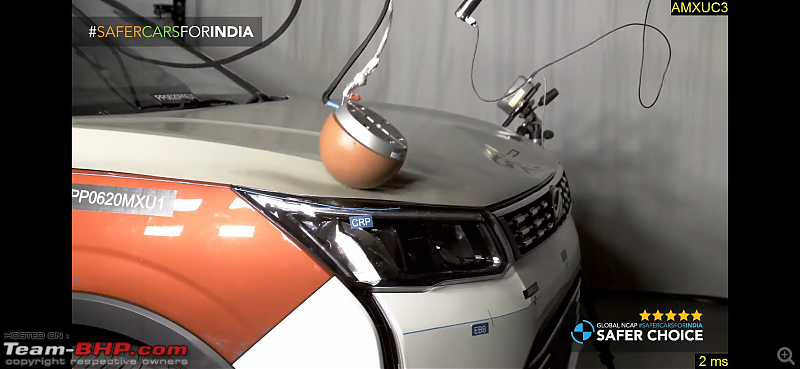 Do note from the code on this XUV that this one arrived in the 6th week, whereas the first three XUVs (for ODB and MDB) arrived in the 3rd week of 2020. The difference here lies in the number of vehicles the manufacturer is willing to sponsor. Tata is willing to sponsor the minimum number of vehicles required for that particular rating, be it 4 or 5-star. Mind you, this isn't a bad thing at all in a country where the manufacturer with the highest market share outright refuses to send their vehicles for a test and calls GNCAP a self proclaimed party, while the manufacturer which is second on the sales chart is better at knowing its mistakes and keeping quiet instead of making ridiculous accusations and citing vague statistics to justify their mistake. Mahindra, on the other hand, is going the extra mile, and sponsoring vehicles for additional tests which make no difference to their rating. Case in point: the side impact test and ESC test for Thar. One could argue that Mahindra's in-house crash data might have suggested a 5-star rating for the Thar and they sponsored the MDB vehicle either because of their incorrect data, or overconfidence. But that is simply not the case, because the ODB vehicle arrived at the lab in the 44th week of 2020, whereas the MDB vehicle arrived in the 46th week. For XUV, one could argue that they sponsored the additional vehicles for pedestrian protection and ESC because it was a requirement for the safer choice award (not sure if it actually is a requirement or not), but then, that doesn't explain them sponsoring the ESC test for the Thar. | ||||
| |  (2)
Thanks (2)
Thanks
|
| The following 2 BHPians Thank rpm for this useful post: | Bibendum90949, ron178 |
 |


